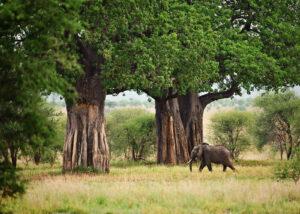Overview
Tanzania provides fantastic and big opportunities to see different animal species. Tanzania is a fantastic location for wildlife enthusiasts, and just one of the three safari circuits offered is highly recommended. Most of the other popular safari animals, including the Big Five, can be spotted with ease. All across, save in the Ngorongoro Crater, black rhinos are extremely rare.
Wildebeest Migration.
One of the most amazing animal displays in Africa is the wildebeest migration. The Mara-Serengeti ecosystem is home to at least two million ungulates, primarily wildebeest but also zebra and gazelle. Another extremely unique time to visit is during the wildebeest calving season. This is a fantastic time to witness some action because of the vast numbers of opportunistic predators drawn to the wildebeest and their calves.
Wildlife Highlights.
The highly endangered African wild dog can be found in rather good numbers in Nyerere and Ruaha, two locations in the Serengeti that are well-known for their quantity of big cats. Africa’s top chimpanzee reserves are Mahale and Gombe Stream.
Best Time for Wildlife Viewing.
When it comes to seeing wildlife, late June through October is the ideal time of year. The Wet Season (November to May) is usually less crowded with tourists and more picturesque. June and July are your best bet for spotting the wildebeest migration. During the long rainy season (March to May), which is when several lodges close, it becomes harder to visit the parks in the Southern and Western circuits.
Wildlife in the Serengeti.
The primary motivation for visiting the Serengeti National Park is to witness wildlife in its expansive, pristine habitat. We promise you won’t be let down in the slightest!
There is simply too much to see and learn about when it comes to animal viewing in the Serengeti, so it is difficult to list all the highlights. From the famous Big 5 of Africa, to countless herds of zebra and
wildebeest, hundreds of bird species, and many smaller critters like the enchanting dung beetle, there is something for everyone.
The Big Five in the Serengeti.
Observing the magnificent Big Five – lion, rhino, leopard, elephant, and Cape buffalo – walking around freely in their natural habitat is an unforgettable experience that epitomizes the true meaning of an African safari. Why those particular species are included in the Big Five, one may ponder. And isn’t a giraffe big too? Fun fact: big game hunters are the ones who came up with the phrase “Big Five,” which has nothing to do with the animals’ sizes. It was largely because of their aggressiveness when cornered that these creatures proved to be the hardest to hunt.
Fortunately, the Big Five in the Serengeti are now exclusively “shot” with a camera. You can cross the Big Five off your list with the aid of your guide and tracker. (In the interim, don’t forget that seeing other animals, such as hippos or giraffes, is equally thrilling.)
Lion.
Seeing a pride of lions in their natural environment will be ingrained in your memory, making them the kings of the African savannah. Good news! There are some very big prides of lions living in the Serengeti, and they are not too difficult to find. Lions are highly gregarious animals and live in prides. In a group, the females hunt more than the males, but the majority will gladly scavenge if given the opportunity, as they enjoy to spend roughly 20 hours a day dozing under trees!
Leopard.
They are referred to as “The Prince of Darkness” because of their magnificent coat and graceful gait. Out of the Big Five, this one is the most reclusive and quiet. Leopards are great at hiding when playing hide-and-seek because they can blend in perfectly if they wish to remain unseen. The likelihood of seeing a leopard napping on a tree branch in the Serengeti is quite high. Their favorite area is among the sausage tree’s big branches. So always remember to look up! A leopard may be high up in a tree enjoying his meal, safe from lions and other predators.
Buffalo.
The buffalo, which has few predators, is one of the most deadly creatures in Africa and is not at all like the sluggish bush cow you might picture. Although lions may attempt to chase after a calf, they will probably pay the price as the enraged herd exacts their punishment. Buffalo frequently congregate around waterholes because they must drink every day. Although they have a reputation for having nasty tempers, especially when hurt, their knowing gaze—which one novelist famously put this way: “They look at you like you owe them money”—makes them fascinating to see. Buffalo are abundant in the Serengeti; it’s likely that you’ll come across herds of at least 1,000 of these fascinating creatures.
African elephant.
Observing the largest land mammal in the world in its native environment is an incredible experience. These gray giants prowl the plains and vanish into the trees of the Serengeti. Elephant females have close-knit tribes and can have 50-year family ties. After 12 years, males frequently depart from the clan to roam alone or form bachelor herds. Elephants frequently stop by nearby waterholes near resorts. When left alone, elephants are calm, but if they sense danger, move aside. There is nothing more terrifying than being pursued by a beast that can lift seven stacked vehicles’ worth of weight and lets out a loud trumpet.
Rhinoceros.
With a weight of 2,500 kg, the rhino is a formidable animal from prehistory. Black and white rhinos are the two species of rhinoceros found in Africa. The white rhino, contrary to popular belief, is actually grey, much like the other rhinos. Early Dutch immigrants mistook the name “white” for something else entirely, considering its wide lips to be “wild,” or wide. Regrettably, the rhinoceros’s horn is more valuable than its entire gold weight. Rhinos in the Serengeti habitat have declined from 1,000 to fewer than 70 individuals over the past few decades, largely as a result of poaching.
From 1,000 rhinos, there were fewer than 70 left. One of the hardest species to detect in Serengeti National Park is the rhino, as the female only gives birth every five years. However, if you have an expert guide by your side, you just might be lucky!
Other wildlife in the Serengeti.
Because the Serengeti is a unique place of transition, it is home to a wide range of wildlife. There is a remarkable range of vegetation and ecosystems throughout the park as a result of the clear transition from rich flat soils in the south to poor hilly soils in the north.
The riverine woodlands are a unique ecosystem that are popular with crocodiles and hippos. The long-neck giraffe is another prevalent mammal. Numerous other ungulates, or hooved animals, are year-round residents and include the eland, zebra, topi, kongoni, impala, and Grant’s gazelle. All three of the huge cats are visible, as mentioned. Lions are omnipresent and frequently encountered during hunting. In contrast to leopards, which are normally seen relaxing in one of the large trees along the Seronera River, cheetahs are quite frequent on the south-eastern plains. Sadly, wild dogs are uncommon; hyenas are frequently seen. Study up on additional fauna.
Always on the fly: birdlife in Serengeti National Park.
After visiting the Serengeti, chances are excellent that you will develop an interest in birdwatching even if you aren’t already. This is a haven for birdwatchers, with over 500 species identified. The majority of guides would gladly show out all the rare species found here, such as the Fischer’s Lovebird, which is painted vivid green and yellow, or the Kuri bustard, which has a striking white beard. The Serengeti-Mara ecosystem is home to five bird species that are unique to Africa, half of which are restricted to the Tanzanian side of the ecosystem. It is also one of Africa’s Endemic Bird Areas, a region significant for habitat-based bird conservation. Learn more about the Serengeti’s birdlife.
Best time for bird watching.
Fortunately, the best times of year to see birds in the Serengeti are from early November to late April. Not only are migrating birds from Europe and North Africa present at this season, but resident species are also nesting during this time. This facilitates the identification of birds in their striking breeding plumage. Study up on the ideal time to travel to the Serengeti.
Small talk: insects in the Serengeti.
If you are not a huge fan of biting and stinging insects, we have good news for you: the Serengeti has got less of them than North America and Europe. This Park has got a remarkably greater diversity of other insects. Numerous guides are eager to share more about the significance of insects, as many of these little animals are vital to the region’s ecology. The termites, grasshoppers, ants, moths, butterflies, and dung beetles are the five important insect groups.
Request Quote
Fill in and send the safari request form, we shall respond as soon as we receive your message. You can also reach us on Whats-app Number: +256753750983 for urgent requests.

